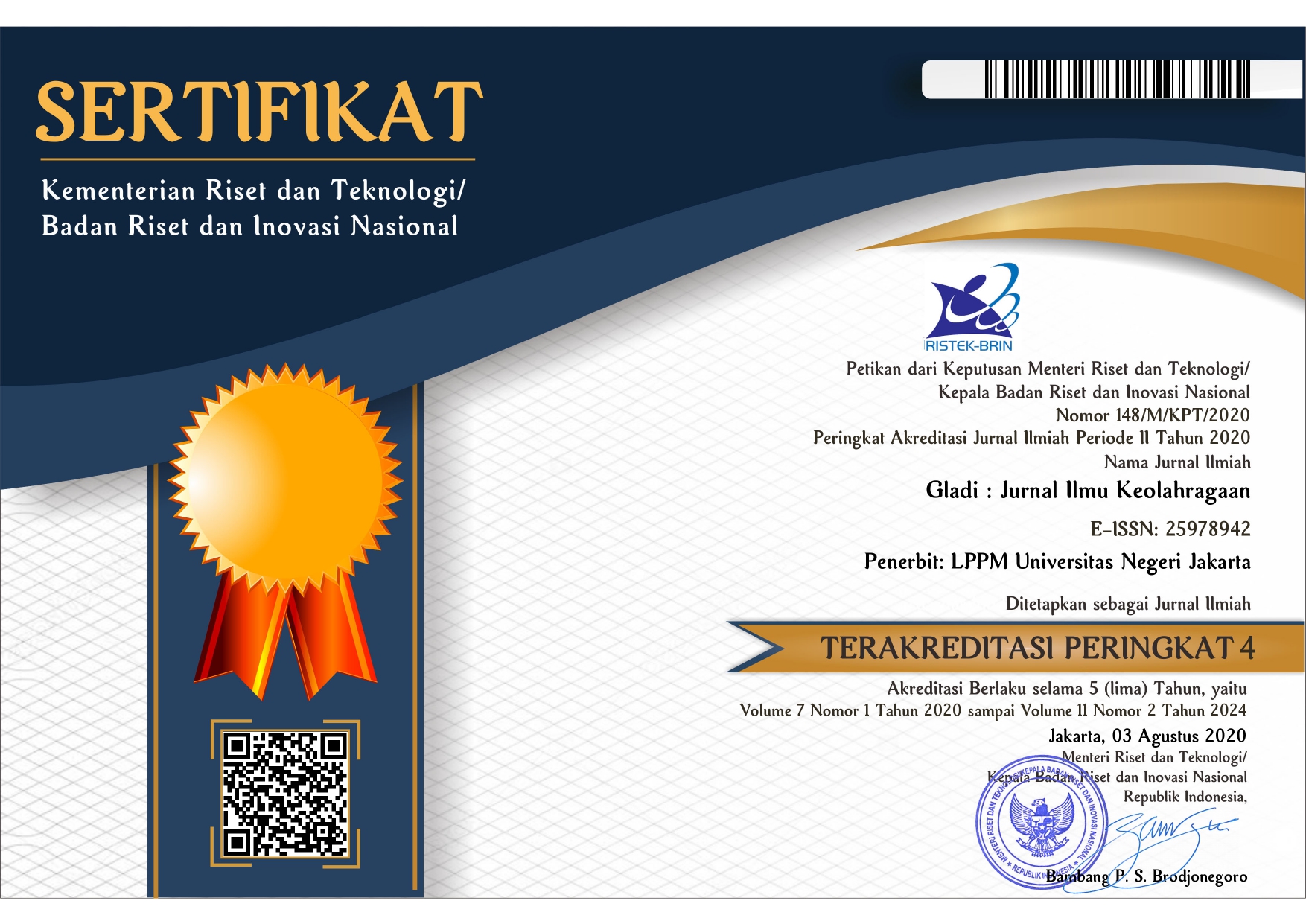Hubungan Antara Tingkat Kepercayaan Diri Dengan Prestasi Belajar Pendidikan Jasmani
DOI:
https://doi.org/10.21009/GJIK.111.05Keywords:
self-confidence; learning achievement; physical educationAbstract
This study aims to examine the level of confidence relationship with physical education learning achievement in elementary schools in the Tawang sub-district, Tasikmalaya City. The research method uses descriptive-correlational. The sample in this study is the sixth-grade students selected representing several schools in the District of Tawang as many as 60 students employing a purposive sampling technique. The instrument used was a confidential questionnaire. Data processing procedures to obtain answers about whether or not the hypothesis is accepted following the proposed significance are: (1) looking for averages, (2) looking for standard deviations, (3) testing normality through the Lillefors test (4) testing the correlation of two variables. Based on the results of research and statistical calculations on hypothesis testing the relationship of the level of confidence with physical education learning achievement, the authors can conclude as follows; there is a significant relationship between self-confidence and student achievement in class VI in Tawang District, Tasikmalaya City. Because the significance value obtained is greater than 0.05, and the value of Yxy (0.90)> (0.250) rtable (0.05) (60) then H0 is rejected and Ha is accepted, so there is a significant relationship between self-confidence and achievement learning (significant).
Downloads
References
Block, M. E. (2016). A Teacher’s Guide to Adapted Physical Education. Paul H. Brookes Publishing.
DKB, D. K. B. (2007). Psikologi pendidikan.
Dweck, C. S. (2000). Self-theories: Their role in motivation, personality, and development. Psychology press.
Hakim, T. (2005). Belajar secara efektif. Niaga Swadaya.
Husdarta, J. S., & Kusmaedi, N. (2010). Pertumbuhan dan Perkembangan Peserta Didik: Olahraga dan Kesehatan. Bandung: Alfabeta.
Husdarta, J. S., & Riduwan. (2010). Sejarah dan Filsafat Olahraga. Alfabeta.
Lengkana, A. S., Tangkudung, J., & Asmawi, M. (2018). THE EFFECT OF POWER LIMBS, SPEED REACTION, FLEXIBILITY AND SELF CONFIDENCE ON THE ACHIEVEMENT OF ELITE ATHLETES ATHLETIC WEST JAVA IN THE TRACK NUMBER. JIPES-JOURNAL OF INDONESIAN PHYSICAL EDUCATION AND SPORT, 4(2), 20–25.
Machida, M., Marie Ward, R., & Vealey, R. S. (2012). Predictors of sources of self-confidence in collegiate athletes. International Journal of Sport and Exercise Psychology, 10(3), 172–185.
Muilenburg, L. Y., & Berge, Z. L. (2005). Student barriers to online learning: A factor analytic study. Distance Education, 26(1), 29–48.
Priastuti, A. W., & HW, S. (2016). Dukungan Fasilitas dan Lingkungan Keluarga terhadap Prestasi Belajar Matematika di SMP.
Rothman, T., Maldonado, J. M., & Rothman, H. (2008). Building self-confidence and future career success through a pre-college transition program for individuals with disabilities. Journal of Vocational Rehabilitation, 28(2), 73–83.
Tongco, M. D. C. (2007). Purposive sampling as a tool for informant selection. Ethnobotany Research and Applications, 5, 147–158.
Unver, V., Basak, T., Watts, P., Gaioso, V., Moss, J., Tastan, S., … Tosun, N. (2017). The reliability and validity of three questionnaires: the student satisfaction and self-confidence in learning scale, simulation design scale, and educational practices questionnaire. Contemporary Nurse, 53(1), 60–74.
Winarno, M. E. (2006). Dimensi Pembelajaran Pendidikan Jasmani dan Olahraga. Malang: Laboratorium







